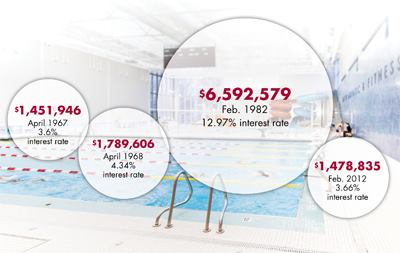When it comes to renovation, today’s aquatics facilities are in a bind. Many are in desperate need of rebuilding or renovation. But coming up with the money is more difficult than ever for most.
One way to loosen the purse strings is to show voters or budget makers that now is the best time in 45 years to build a new, renovated or replacement municipal swimming pool facility.
That’s due to a rare convergence of two key money-saving trends.
First, interest rates on municipal bonds are the lowest they have been since April 1967. Second, construction costs are as low as we have seen in the past 10 years.
Taken together, these two forces mean that if a municipality needs to build a new, renovated or replacement aquatics facility at any time over the next 10 or 15 years, it should act now. This brief window of opportunity to finance such improvements at the lowest possible cost is here today, but if history repeats itself — as it almost always does — it likely will not occur again within the next 30 to 50 years.
The financial benefit will be dramatic. Communities that wait and are forced to make such improvements when costs rise again probably will regret missing out on this historic opportunity.
A look at 20-year municipal bond interest rates over time indicates historically sharp increases soon after periods of low interest rates, as exists today. Experiencing interest rates lower than today is highly unlikely because the Federal Reserve borrowing rate for banks is effectively nothing, and the bond markets have aligned as low as practical to this rock-bottom rate.
The 20-year municipal bond rate in August was 2.53 percent. The only comparable time in history was April 1967, when the rate was 3.6 percent, according to economagic.com.
Using historical interest rates, if an aquatics facility had been renovated or constructed with a 20-year municipal bond and an initial project cost of $3.5 million in April 1967 (when the interest rate was 3.6 percent) instead of April 1968 (when the interest rate was 4.34 percent), a savings of $337,661 would have been realized over the life of the bond. If the same facility were constructed in February 1982 (when the interest rate was 12.97 percent) instead of April 1967, the project would have cost $5.1 million more over the life of the bond.
So what can we expect from interest rates going forward? It is anticipated by most financial forecasters that interest rates will begin to rise significantly soon.
The most important factor that influences interest rates is inflation. As the U.S. economy continues to move forward out of the current recession, there will be more pressure on prices due to increased demand. To counter inflationary pressures, the Federal Reserve always raises interest rates. Once the Fed rates start to rise and investors require higher overall rates of return as a result, all other bond rates will follow suit, including municipal bonds. When this trend starts, cities that did not act when rates were low (that is, now) will be forced to pay higher costs.
In addition to lower funding costs for aquatic projects, an analysis of construction costs reveals a similar cost savings trend. We found that the rising construction cost trend between 2003 and 2009 typically resulted in a 25 percent total increase in construction costs over this time period. After 2009, however, we noticed a decrease in overall construction cost trends. In fact, today’s aquatics industry construction costs for renovation or new construction are very similar to those of 2003.
After discussing this downward trend with contractors in the aquatics industry, we found that the decreases were not necessarily in the cost of the products placed on the job, but were mostly related to the decrease in profit margins for the contractors and equipment manufacturers. In other words, while many raw material prices increased somewhat, most of the companies involved with refining raw goods into finished construction were deriving very little profit for their efforts.
This is most definitely a trend that will reverse itself as our economy improves and demand for construction rises again. Only municipalities that act now will reap the benefits of this trend and, at the same time, help improve our overall economy by strengthening the construction work force. So as you can see, there’s a “perfect storm” of price factors that make building a new or renovated aquatics facility today as inexpensive as it probably ever will be. Municipalities that take advantage of these cost savings now, instead of waiting and being forced to act when prices are significantly higher, will be part of the wise elite.



